Articles
The Cape Porcupine Complex, northern mainland Nova Scotia – no longer a geological orphan
ABSTRACT
The Cape Porcupine Complex west of the Strait of Canso in northern mainland Nova Scotia consists of mainly fault-bounded units of metasedimentary, metavolcanic, and granitoid rocks. A previously reported U-Pb (zircon) age of 610 ± 3 Ma from syenogranite combined with petrological characteristics indicates that some of the granitic rocks and possibly an associated body of leucodiorite are Late Neoproterozoic. In contrast, alkali-feldspar granite from a more extensive suite of quartz alkali-feldspar syenite/alkali-feldspar syenite, alkali-feldspar granite/syenogranite, and quartz alkali-feldspar leucosyenite with A-type characteristics yielded an early Ordovician age of 478 ± 3 Ma. Similar A-type chemical characteristics suggest that the metavolcanic unit may be the extrusive equivalent of the Ordovician suite.
Similarities in age and petrological characteristics indicate that the Cape Porcupine Complex is linked to rock units in the Antigonish Highlands. The ca. 610 Ma granitic rocks are likely related to plutonic and volcanic rocks of similar age in the Antigonish Highlands interpreted to have formed at a continental margin subduction zone. In contrast the A-type syenitic and metavolcanic rocks are probably related to the compositionally similar West Barneys River plutonic suite and younger volcanic rocks formed in an extensional regime. Such rocks do not occur in adjacent Ganderia or Avalonia in Cape Breton Island or southern New Brunswick, further demonstrating the regional significance of the Canso Fault in tectonic reconstructions.
RÉSUMÉ
Situé à l’ouest du détroit de Canso au nord de la partie continentale de la Nouvelle-Écosse, le complexe du cap Porcupine se compose principalement d’unités rocheuses métasédimentaires, métavolcaniques et de granitoïdes limitées par des failles. Une datation réalisée précédemment par la méthode U-Pb sur zircon et qui a établi un âge de 610 ± 3 Ma à partir du syénogranite et des caractéristiques pétrologiques indique qu’une partie des roches de granite et vraisemblablement un corps connexe de leucodiorite sont du Néoprotérozoïque tardif. Par contraste, du granite de feldspath alcalin d’une succession plus importante de syénite de feldspath alcalin quartzeux/syénite de feldspath alcalin, de granite de feldspath alcalin/syénogranite, et de leucosyénite de feldspath alcalin quartzeux présentant des caractéristiques de type A a produit un âge de l’Ordovicien précoce, soit environ 478 ± 3 Ma. Ces caractéristiques chimiques de type A analogues portent à croire que l’unité métavolcanique pourrait être l’équivalent extrusif de la succession de l’Ordovicien.
Les similitudes de datation et les caractéristiques pétrologiques indiquent que le complexe du cap Porcupine est relié aux unités rocheuses des hautes-terres d’Antigonish. L’âge du granite, d’environ 640 Ma, se rapporterait vraisemblablement aux roches plutoniques et volcaniques de la même époque observées dans les hautes-terres d’Antigonish, dont on suppose qu’elles ont été formées dans une zone de subduction de la marge continentale. Par contraste, les roches métavolcaniques et syénitiques de type A sont probablement reliées par la similitude de leur composition au cortège plutonique et aux roches volcaniques plus jeunes de la rivière Barneys Ouest formées dans un milieu de distension. Ces roches ne sont pas présentes dans la partie adjacente de Ganderia ou d’Avalonia sur l’île du Cap-Breton ou dans le sud du Nouveau-Brunswick, ce qui tendrait à souligner encore plus l’importance régionale de la faille de Canso dans les reconstructions tectoniques.
[Traduit par la redaction]
INTRODUCTION
1 Porcupine Mountain is a prominent hill adjacent to the Strait of Canso in northern mainland Nova Scotia (Fig. 1). The northeastern part of the hill, marked by a prominent 150 m-high scarp known as Cape Porcupine (Fig. 2), was quarried for the construction of the Canso Causeway in the 1950s, and continues to be a major source of high quality aggregate for local and worldwide markets. Porcupine Mountain consists of varied metasedimentary, metavolcanic, and granitoid rocks which were collectively termed the Cape Porcupine Complex by White and Barr (1998a, b). These rocks form an inlier surrounded by Carboniferous sedimentary rocks (Fig. 2). White et al. (2001, 2003) reported results of mapping, petrological work, and U-Pb dating which showed that the Cape Porcupine Complex does not correlate in rock types or age with pre-Carboniferous rocks in adjacent Cape Breton Island. This observation is consistent with its location west of the Canso Fault, interpreted to be a major pre-Carboniferous fault which displaced terranes from New Brunswick about 100 km to the southeast to Cape Breton Island (Fig. 1 inset). Less easy to explain at that time was the fact that the rocks of the Cape Porcupine Complex also did not appear to resemble any pre-Carboniferous rocks reported to be present elsewhere in northern mainland Nova Scotia, so the area appeared to be an orphan in terms of regional correlations.
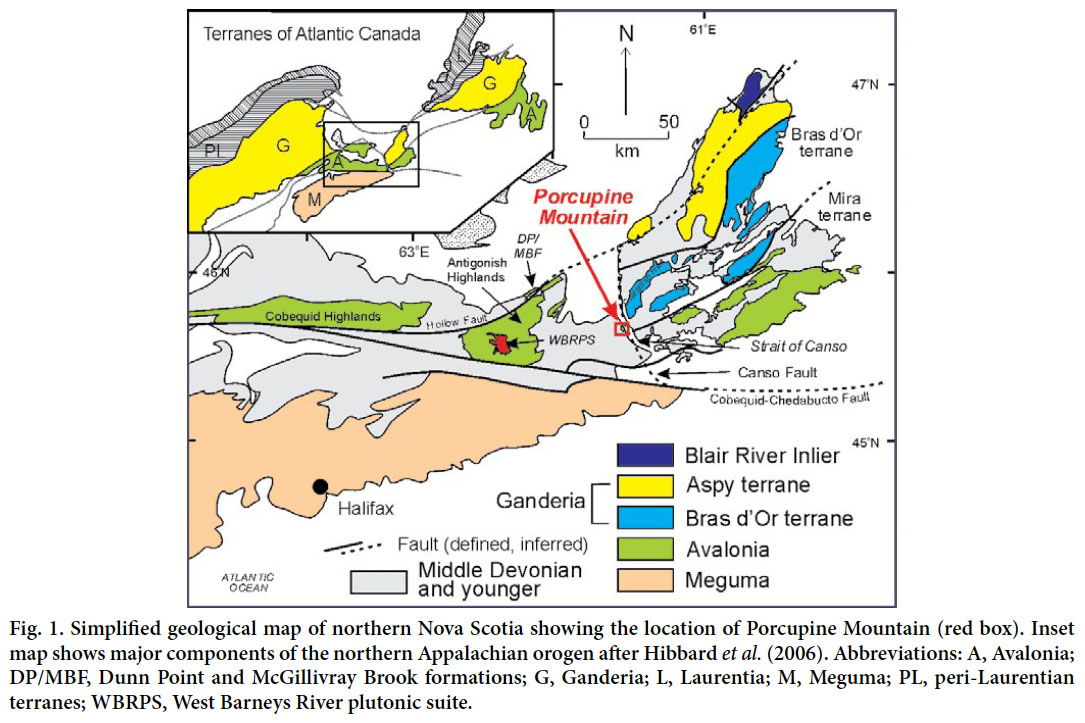 Display large image of Figure 1
Display large image of Figure 1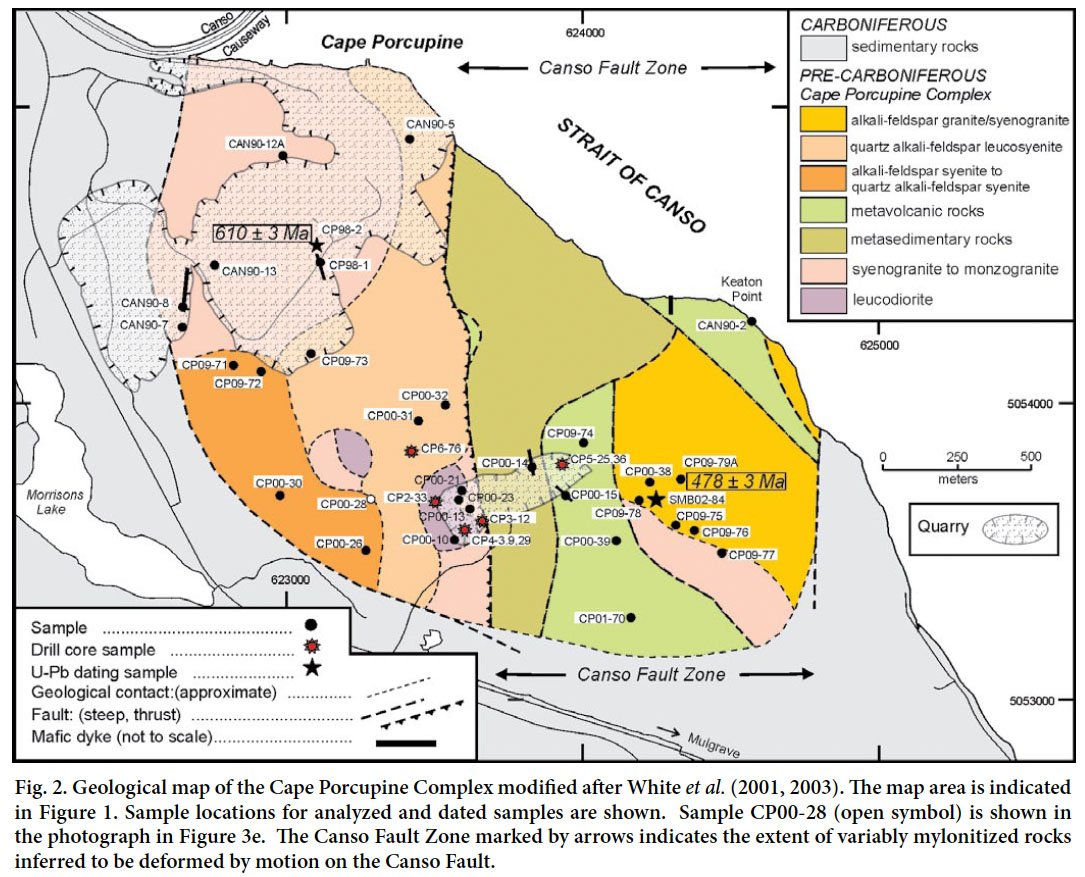 Display large image of Figure 2
Display large image of Figure 22 The purpose of this paper is to revisit the geology of the Cape Porcupine Complex in the light of new data emerging from the Antigonish Highlands, where recent mapping has shown the presence of previously unrecognized Ordovician rocks (White and Archibald 2011; White et al. 2011; Escarraga et al. 2012), some of which, as documented here, are petrologically similar to parts of the Cape Porcupine Complex. We also present previously unpublished analytical data for the U-Pb (zircon) age reported for a granitic unit by White et al. (2003) and new chemical data for metavolcanic and plutonic units which enable interpretation of their chemical affinity and tectonic setting. Age and petrological similarities now support a link between the Cape Porcupine Complex and units in the Antigonish Highlands.
REGIONAL GEOLOGICAL SETTING
3 The Antigonish Highlands of northern mainland Nova Scotia and the Mira terrane of southern Cape Breton Island are both part of Avalonia (Fig. 1), characterized by Neoproterozoic volcanic, sedimentary, and plutonic rocks overlain by Cambrian-Ordovician mainly sedimentary rocks (e.g., Hibbard et al. 2006). However, Avalonia is a composite terrane, and the rocks of the Mira terrane cannot be correlated directly with those of the Antigonish Highlands (Barr et al. 1996). In addition to stratigraphic and age differences in the Neoproterozoic-Cambrian units, the Antigonish Highlands include Ordovician-Devonian volcanic-sedimentary sequences (Murphy et al. 1991, 2008) not present in the Mira terrane. This difference has been further documented during recent mapping and petrological studies in the Antigonish Highlands, which also demonstrated the presence of a large, previously unrecognized Ordovician plutonic suite (Escarraga 2010; White and Archibald 2011; White et al. 2011; Archibald 2012; Escarraga et al. 2012).
4 In Cape Breton Island, the boundary between Avalonia (Mira terrane) and adjacent Ganderia (Bras d’Or terrane) extends through Bras d’Or Lake to the Strait of Canso where it is offset to the north along the Canso Fault, postulated to follow the western margin of the Creignish Hills (Fig. 1). The orientation of this pre-Carboniferous fault was inferred in part from the presence of mylonitic rocks in the Cape Porcupine Complex (White et al. 2001), located on the western side of the Strait of Canso opposite the inferred termination of the Mira - Bras d’Or terrane boundary (King 2002).
GEOLOGY OF PORCUPINE MOUNTAIN
Introduction
5 The complexity of rock types on Porcupine Mountain has been known for more than a century. Fletcher (1881, 1884) divided the mountain into a “central slate series” surrounded by “syenite” and “felsite”, unconformably overlain by Devonian sedimentary rocks. Ferguson (1946) and Ferguson and Weeks (1950) subdivided the slate series and felsite into an older unit of andesite, chlorite schist, rhyolite, and felsite, intruded by younger granite and alaskite, and overlain by Carboniferous sedimentary rocks of the Horton Group. Graves (1990) further documented the variety of rock types and noted the high degree of epidotization, quartz veining, and cataclasis, as well as the presence of mylonitic rocks.
6 White et al. (2001, 2003) divided the rocks into variably mylonitic metasedimentary, metavolcanic, and varied plutonic units, separated from one another by major faults, and also in faulted contact on the north, east, and west with Carboniferous conglomerate, sandstone, and slate (Fig. 2). On the southern margin of the hill, an unconformable relationship between the older rocks and overlying sedimentary rocks is indicated by the presence of a basal conglomerate that contains abundant clasts derived from the underlying units. A north- to northwest-trending and steeply dipping mylonitic fabric is present throughout the metasedimentary unit and most of the metavolcanic unit, and is locally developed in the plutonic units in the area east of the metavolcanic unit (Fig. 2); sense of motion inferred from asymmetric, subhorizontal porphyroclasts and C-S fabrics is dextral strike-slip (White et al. 2001, 2003). These mylonitic rocks are the only known exposure of the Canso Fault.
Metasedimentary Unit
7 Metasedimentary rocks of uncertain age occupy the central area of the Cape Porcupine Complex (Fig. 2). The western contact is a brittle thrust fault dipping to the west. Based on slickenside striations the granitoid rocks appear to be thrust eastward over the metasedimentary rocks. On the east, the metasedimentary rocks are in contact with metavolcanic and granitoid rocks along a near-vertical fault.
8 The metasedimentary unit consists mainly of grey to black, fine-grained and strongly foliated and lineated metasiltstone, locally with thin (<0.5 mm thick), light grey, fine-grained metasandstone lenses. Rare grey, fine-grained quartzite occurs in laterally discontinuous layers, 1–2 m in thickness. The well developed mylonitic foliation is defined by asymmetric muscovite and chlorite that display uniform crystallographic orientation. The muscovite in two samples yielded 40 Ar/ 39 Ar plateau ages of 364 ± 2 Ma and 367 ± 3 Ma, an indication of the age of mylonitization and a minimum age for the metasedimentary unit (Reynolds et al. 2004).
Metavolcanic Unit
9 The metavolcanic unit forms two separate bodies in the eastern part of Porcupine Mountain, one east of the metasedimentary unit and the other along the Canso Strait in the vicinity of Keaton Point, as well as a small fault-bound sliver adjacent to the fault on the western margin of the metasedimentary unit (Fig. 2). In all three areas, the rocks are dominantly grey to dark grey, crystal to crystal-lithic rhyolitic tuff. Crystals are small (<3 mm maximum diameter) and include rounded embayed quartz, subhedral K-feldspar (anorthoclase, based on the presence of fine-scale cross-hatch twinning), and subhedral plagioclase set in a locally spherulitic groundmass of cryptocrystalline quartz and feldspar. Lithic clasts are generally small (<1 cm in diameter), flattened parallel to foliation, and typically consist of rhyolitic tuff. Clasts of andesitic tuff and metasiltstone are rare. Like the metasedimentary rocks, the metavolcanic rocks are strongly foliated and lineated, the latter defined by elongate quartz crystals and lithic clasts. Volcanic layering is typically difficult to recognize because of the strong mylonitic foliation and, where visible, has been transposed parallel to foliation.
10 Because of structural complexities, the original relationship of the metavolcanic and metasedimentary rocks is uncertain. The presence of rare metasiltsone clasts in the metavolcanic rocks and metavolcanic lenses in the metasiltstone unit suggests that they may have been interlayered originally, although their juxtaposition could also be entirely tectonic. Three attempts to date samples from the meta-rhyolite unit were unsuccessful due to absence of zircon.
Plutonic Rocks
11 Varied plutonic rocks form two-thirds of Porcupine Mountain (Fig. 2). Identification of the different varieties is difficult in the field because of their intimate association and widespread cataclastic and/or mylonitic overprints. However, petrographic features enabled division of the plutonic rocks into five units (Fig. 2). The rocks are named based on modal composition estimates from thin section study and slabs stained for K-feldspar (Hutchison 1974), using the terminology of Streckeisen (1976). Typical examples are shown in Figure 3.
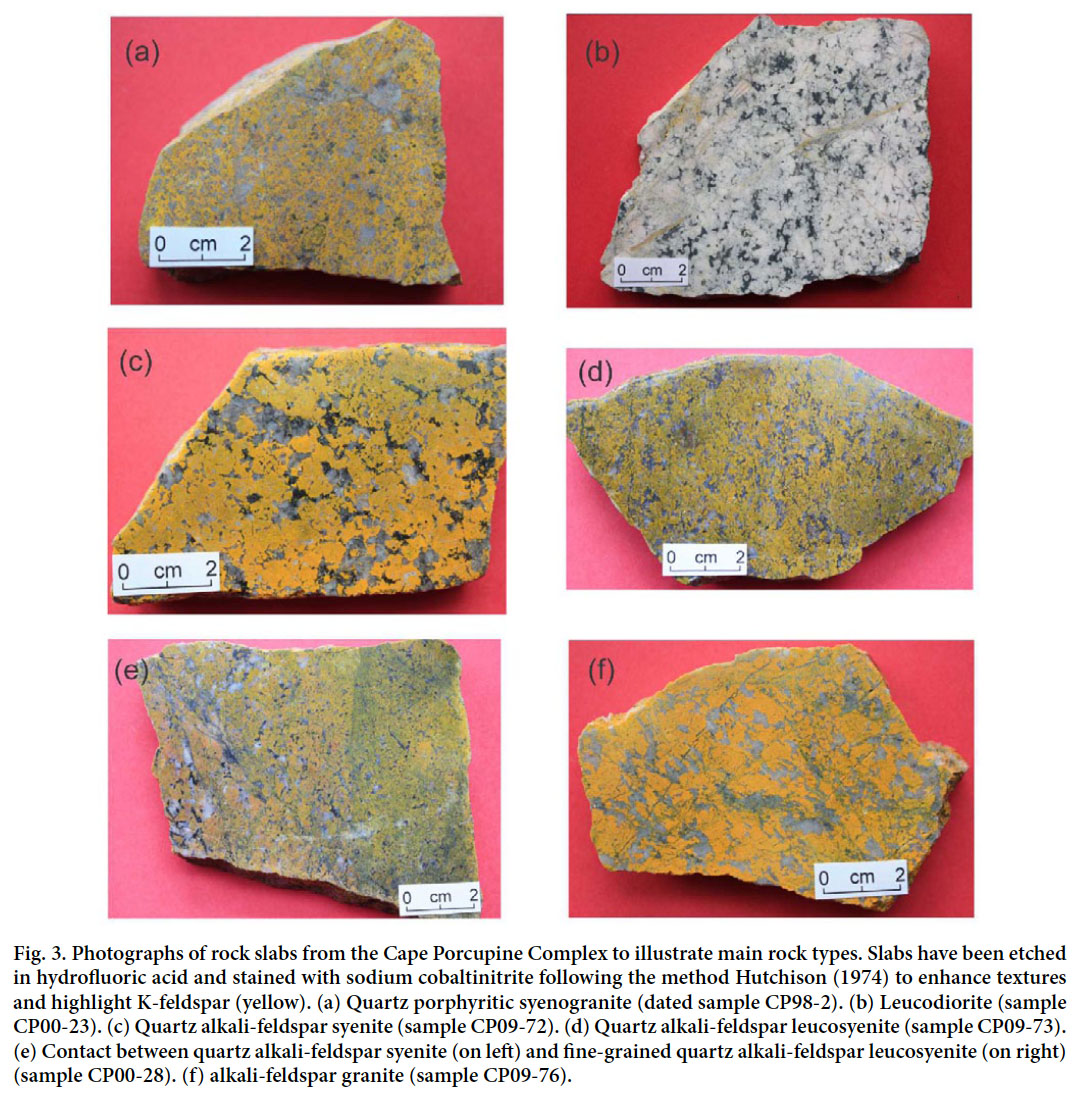 Display large image of Figure 3
Display large image of Figure 3Monzogranite/syenogranite
12 Pink to red monzogranite gradational to syenogranite forms the northwestern part of Porcupine Mountain, as well as smaller area in the south and southeast (Fig. 2). Especially in the northwestern areas, where it is well exposed in the main quarry, it is mixed with abundant enclaves of mafic plutonic rocks and metavolcanic rocks of andesitic to rhyolitic composition, and cut by abundant mafic dykes. Texture varies from coarse-grained equigranular to medium-grained porphyritic, the latter with phenocrysts of quartz and plagioclase up to 1 cm in length (Fig. 3a). Interstitial granophyre generally is present in syenogranite samples. Mafic minerals may have originally been hornblende and biotite, but they have been entirely altered to chlorite and iron oxides. Accessory minerals include zircon, titanite, apatite, and magnetite. White et al. (2001) published a U-Pb (zircon) age of 610 ± 3 Ma from a quartz-porphyritic syenogranite sample typical of the unit.
Leucodiorite
13 Leucodiorite forms small areas associated with monzogranite/syenogranite in the southwestern part of the mountain (Fig. 2). The leucodiorite is generally white to light grey, medium- to coarse-grained and inequigranular, and typically consist of a framework of subhedral plagioclase grains and interstitial mafic minerals (chlorite and amphibole), locally forming up to 30% of the rock (Fig. 3b). The plagioclase is completely altered to saussurite. The rock is named leucodiorite because it contains amphibole rather than pyroxene. The relationship of these highly altered rocks to the ca. 610 Ma monzogranite/syenogranite is uncertain, but their close spatial association suggests that they may be of similar age.
Quartz alkali-feldspar syenite to alkali-feldspar syenite
14 Quartz alkali-feldspar syenite gradational to alkali-feldspar syenite occurs in the southwestern part of the mountain (Fig. 2). These rocks are typically red, medium-to coarse-grained, and highly magnetic (measured susceptibility values up to 63 × 10 -3 SI units). They are composed of euhedral to subhedral, coarsely perthitic alkali feldspar and varying amounts of interstitial quartz (Fig. 3c). Dark green euhedral amphibole, altered fayalite(?), and chlorite (after biotite?) locally constitute up to 10% of the rock. Magnetite is abundant (up to 10%), much of it replacing what may have been fayalite crystals, by comparison with similar alteration in syenite in the West Barneys River plutonic suite of the Antigonish Highlands in which elict fayalite has survived (Escarraga 2010). Titanite and apatite are additional accessory phases.
Quartz alkali-feldspar leucosyenite
15 Quartz alkali-feldspar leucosyenite occurs in the central part of Porcupine Mountain, west of the metasedimentary unit (Fig. 2). It consists mainly of perthitic alkali feldspar and quartz, and mafic minerals are less abundant than in the quartz alkali-feldspar syenite to alkali-feldspar syenite (Fig. 3d). It also tends to be finer grained, and interstitial granophyric texture is typically present. Magnetite is an abundant accessory mineral, and this unit also is magnetic (measured susceptibility values up to 40 × 10-3 SI units). The leucosyenite intruded the coarse-grained alkali-feldspar syenite, based on what appears to be a chilled margin in the leucosyenite at a sharp contact observed in the southwestern part of the area (Fig. 3e).
Alkali-feldspar granite and syenogranite
16 Alkali-feldspar granite gradational to syenogranite forms much of the southeastern part of Porcupine Mountain, and is in faulted contact with the metasedimentary and metavolcanic units, and locally with older granitic rocks (Fig. 2). These rocks are typically more deformed than those in the western belt and in places discrete mylonite zones are present, which appear to correspond to the “gneissoid” beds of Fletcher (1881). In these zones, few of the primary igneous features are preserved, but the rocks appear to have been coarse grained, with abundant quartz and alkali feldspar (Fig. 3f). The mylonite contains abundant quartz ribbons and K-feldspar augen in a fine-grained cataclased quartz-feldspar groundmass. Local areas of quartz alkali-feldspar syenite similar to that in the western area are also present but could not be mapped out as separate units. Overall, these rocks are much less magnetic than the syenitic units in the western part of the complex; the highest measured susceptibility is 9 × 10 -3 SI units, and most samples have susceptibilities of less than 1. Gabbroic rocks occur in the northwestern part of the unit, intruded by small cross-cutting dykes of alkali-feldspar granite. Although the rocks are poorly exposed in that area, the relationships and rock types are similar to those described in the Poor Farm Brook composite pluton in the Antigonish Highlands (White and Archibald 2011; White et al. 2011; Archibald 2012).
Mafic Dykes
17 Mafic dykes occur in all units of the Cape Porcupine Complex, as well as in the surrounding Carboniferous rocks (e.g., White and Barr 1998a; Giles et al . 2010). They are typically 1 to 2 m wide, although the largest observed dyke is about 5 m wide, and are fine to medium grained with well developed chilled margins. Dykes vary from undeformed with relatively unaltered plagioclase and pyroxene, to intensely altered and dominated by actinolitic amphibole and/or chlorite instead of clinopyroxene. Some dykes cut mylonitic fabrics in the metasedimentary and metavolcanic units.
U-Pb (Zircon) Geochronology
18 A U-Pb (zircon) age of 610 ± 3 Ma was published previously for syenogranite sample CP98-2 from the monzogranite to syenogranite unit (White et al . 2001). White et al. (2003) reported a U-Pb (zircon) age of 478 ± 3 Ma for sample SMB02-84 from the eastern alkali-feldspar granite unit, but the supporting analytical data were not included. Hence we present those data here.
19 Sample SMB02-84 is brecciated mylonitic alkali-feldspar granite, in which the original texture was likely coarse but now consists of quartz ribbons around K-feldspar clasts. The sample was processed in the Jack Satterly Laboratory at the Royal Ontario Museum using a jaw crusher for initial crushing, a disk mill for sample reduction to sand-sized particles, and a Wilfley table, heavy liquids (bromoform and methylene iodide) and a Frantz magnetic separator for isolation of heavy mineral fractions. Zircon was selected from the least paramagnetic fraction by hand picking under a binocular microscope. Picked zircons were given an air abrasion treatment to eliminate cracked grains and remove exterior surfaces (Krogh 1982) before final selection of grains for analysis. The weight of each fraction (3 or 4 grains) was measured using a microbalance. As the weights are normally small (generally <3 micrograms), both the measured and estimated weights are accurate only to about ±50%. However, this only affects the calculation of Pb and U concentrations and has no influence on age data.
20 The selected grains were washed in 4N and then 7N HNO3 and loaded into Teflon bombs with HF and a measured amount of 205Pb - 235U isotopic tracer solution (Krogh 1973). Dissolution occurred over four to five days at 195 °C. No chemical isolation of U and Pb was carried out on the dissolved grains. Fractions were dried down with phosphoric acid and then loaded with silica gel onto outgassed rhenium filaments. The isotopic compositions of Pb and U were measured using a single Daly collector with a pulse counting detector in a solid source VG354 mass spectrometer. A detector mass discrimination of 0.14% per atomic mass unit (AMU) and a deadtime of 22.5 nsec were employed for Daly detector measurements. A thermal source mass discrimination correction of 0.1% per atomic mass unit for both Pb and U was also used. Assigned laboratory blank for U is 0.2 pg. Total measured common Pb in samples was below 1 pg in nearly all cases and was assigned the isotopic composition of lab blank (see footnotes to Table 1). Error estimates were calculated by propagating known sources of analytical uncertainty for each analysis including ratio variability (within run), uncertainty in the fractionation correction, and uncertainties in the isotopic composition of laboratory blank. Decay constants used are those of Jaffey et al. (1971). All uncertainties are reported at the 95% confidence level. Discordia lines and concordia intercept ages were calculated by the method of Davis (1982) using the in-house program ROMAGE, as were average 207Pb/206Pb ages and 206Pb/238U ages. Probability of fit measures the scatter of analyses with respect to a Pb-loss line. A value of around 50% would be expected for unimodal data sets with correctly chosen analytical errors. Low probability of fit suggests real differences in Pb loss history and/or zircon crystallization age.
21 The zircon population consisted of colourless, equant, euhedral prisms of good to excellent quality. Most were four-sided and characterized by either igneous growth zoning or metamorphic overgrowths on igneous cores. The consistency of the age data at 478 ± 3 Ma (Fig. 4; Table 1) strongly indicates the former. Although igneous units of similar Ordovician age were unknown when this age was first reported (White et al. 2003), an age of 469 ± 0.5 Ma was obtained recently from quartz syenite of the West Barneys River plutonic suite in the Antigonish Highlands (Escarraga 2010; Escarraga et al. 2012), suggesting a relationship as discussed in more detail below.
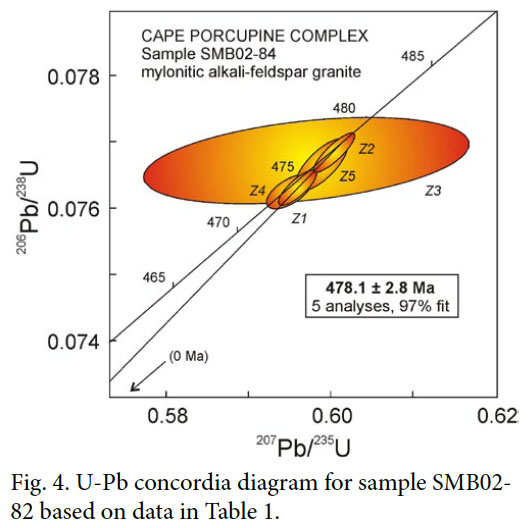 Display large image of Figure 4
Display large image of Figure 4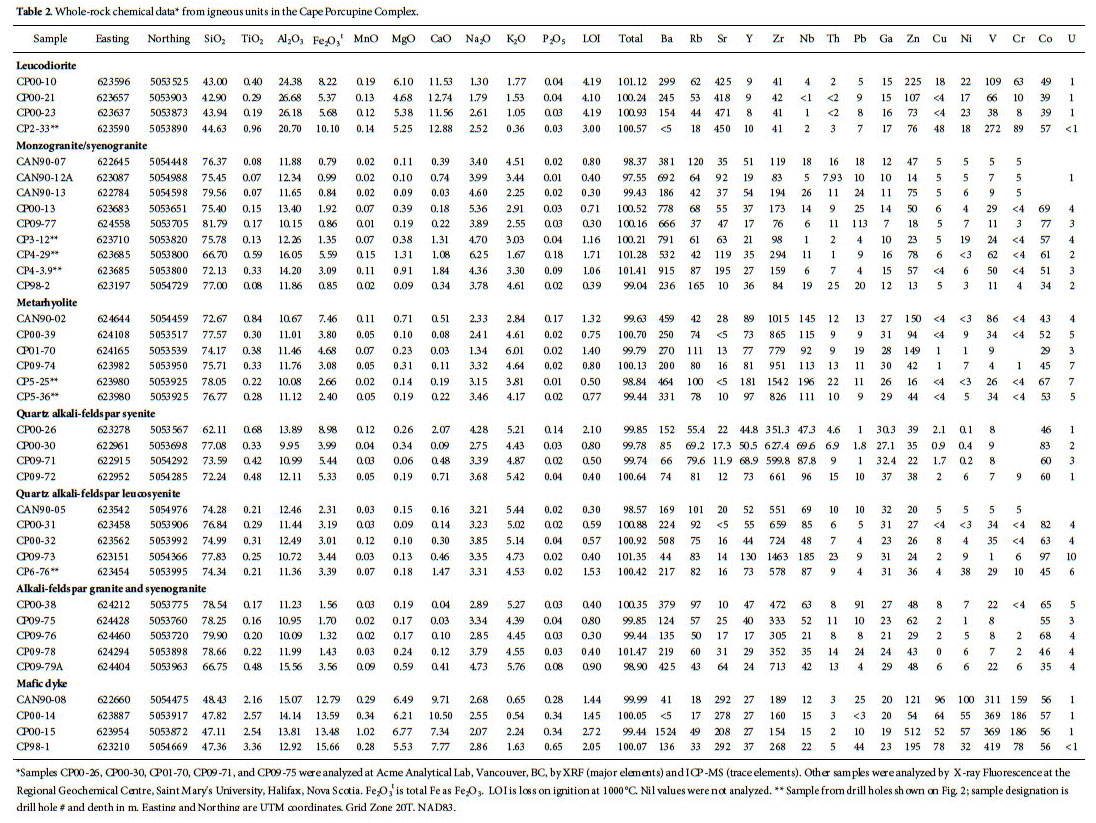 Display large image of Table 2
Display large image of Table 2Geochemistry
22 Whole-rock chemical data were obtained for typical samples from igneous and meta-igneous units (Table 2). The data are plotted on diagrams to illustrate their chemical characteristics, and are also compared to data from plutonic units from the Antigonish Highlands based on the work of Escarraga (2010), Murray (2011), and Archibald (2012). The Antigonish Highlands data are shown as fields on the diagrams.
Felsic-intermediate samples
23 The monzogranite/syenogranite samples (referred to collectively as the granitic suite) range in SiO2 from about 70 to 80%, with one monzogranitic sample containing 67% (Fig. 5). As a group, they are characterized by negative correlations between SiO2 and TiO2, Al2O3, Fe2O3t, MgO, CaO, and P2O5, whereas Na2O and K2O are more scattered.
24 The quartz alkali-feldspar syenite/alkali-feldspar syenite, quartz alkali feldspar leucosyenite, and alkali-feldspar granite/syenogranite samples (referred to collectively as the syenitic suite) also have SiO2 between 70–80%, except for two alkali-feldspar syenite samples (CP00-26 from the western body and CP09-79A from the eastern body) with 62% and 66.7% SiO2, respectively). Both of these samples are dominated by K-feldspar and contain very little modal quartz, consistent with their relatively low SiO2 content compared to other samples. The syenite sample from the western body also contains some separate plagioclase grains and a higher abundance of mafic minerals (including magnetite) than other syenitic samples, consistent with its higher Al2O3, Fe2O3t, and CaO (Fig. 5b, c, e). With the exception of these two samples, the other analyzed samples show overall similarity in major element compositions. Compared to the granitic suite, they tend to have lower Al2O3, CaO, and Na2O, and higher Fe2O3t and especially K2O (Fig. 5).
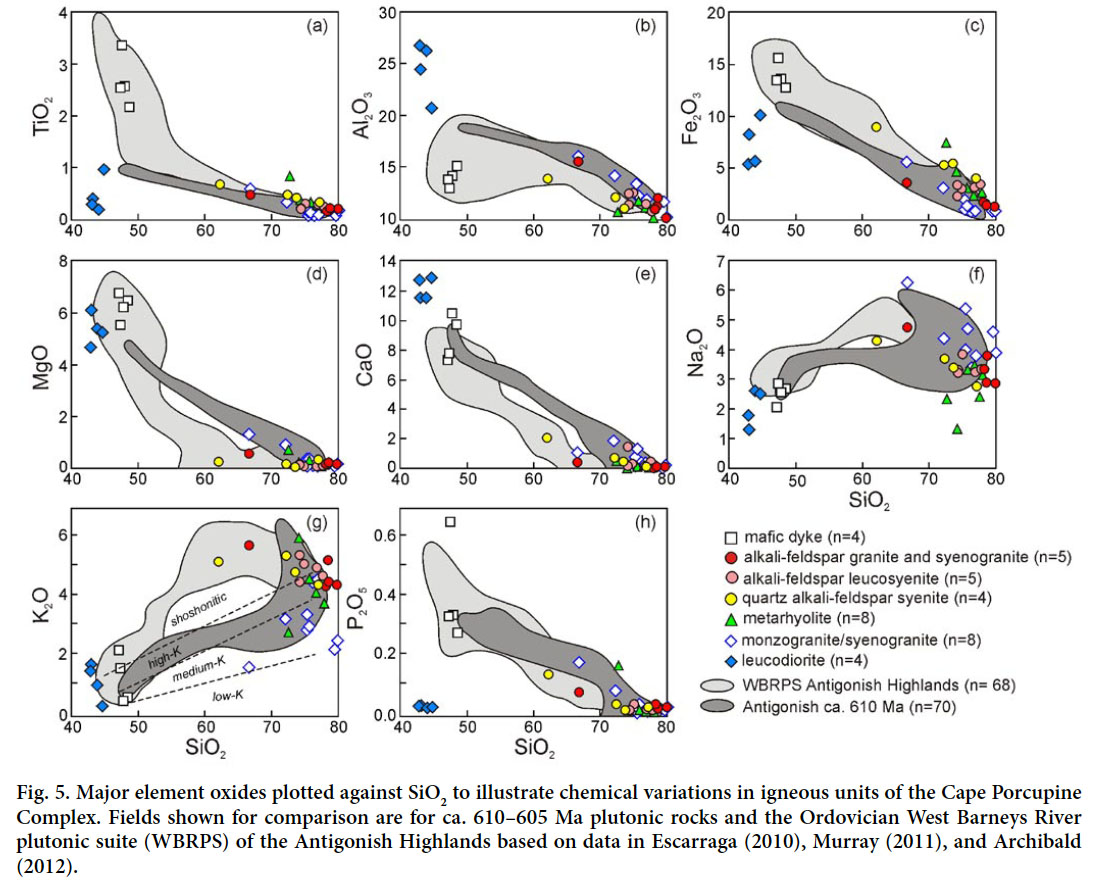 Display large image of Figure 5
Display large image of Figure 525 The metarhyolite samples also have high SiO2 contents overlapping with those in both the granitic and syenitic suites. Their overall chemical features are more similar to those of the syenitic suite than to the granitic suite, including low Al2O3, CaO, and Na2O and high Fe2O3t and K2O, although one sample has low K2O.
26 Although designed for volcanic rocks, a plot of Zr/TiO2 against Nb/Y is useful for further illustrating the differences between the syenitic and granitic suites (Fig. 6a). Even with similar SiO2 contents, the syenitic suite has higher Nb/Y than the granitic suite, and the samples plot in the alkalic fields as the intrusive equivalents of volcanic rocks such as trachyte and alkali rhyolite. The metarhyolite samples also plot in those fields. In contrast, the granitic samples are subalkalic and plot mainly in the rhyolite +dacite fields. On a plot of FeOt/FeOt + MgO ratio against SiO2, the granitic, syenitic, and metarhyolite samples all plot in the ferroan and A-type granite fields, although the granitic samples tend to have lower FeOt/FeOt + MgO ratios and some cross into the magnesian granite field of Frost et al. (2001). On diagrams designed to characterize A-type granitoid rocks compared to I- and S-type, the syenitic and metarhyolite samples have high Ga/Al ratios and elevated Zr and Nb contents typical of A-type granitoid rocks (Fig. 7a, b). In contrast, the granitic samples plot in the field for I- and S-type granitoid rocks. The differences are also apparent on the tectonic setting discrimination diagrams (Fig. 7c, d), on which most of the syenitic and all the metarhyolite samples plot in the within-plate granite fields, whereas the granitic samples lie in the volcanic-arc granite field or slightly into the within-plate granite field, as is typical of evolved I-type granitoid suites.
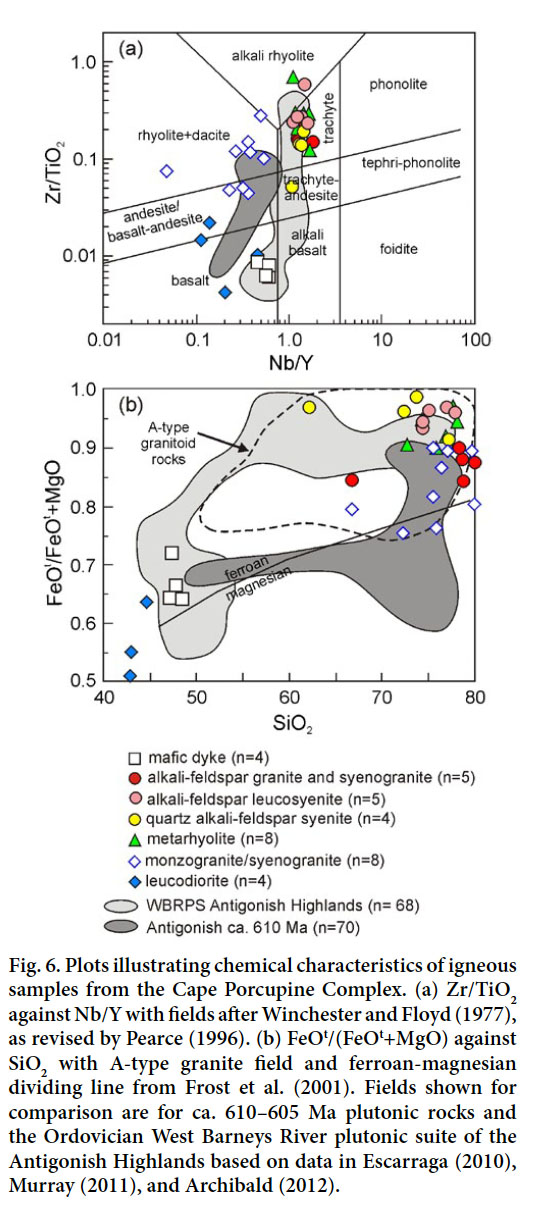 Display large image of Figure 6
Display large image of Figure 6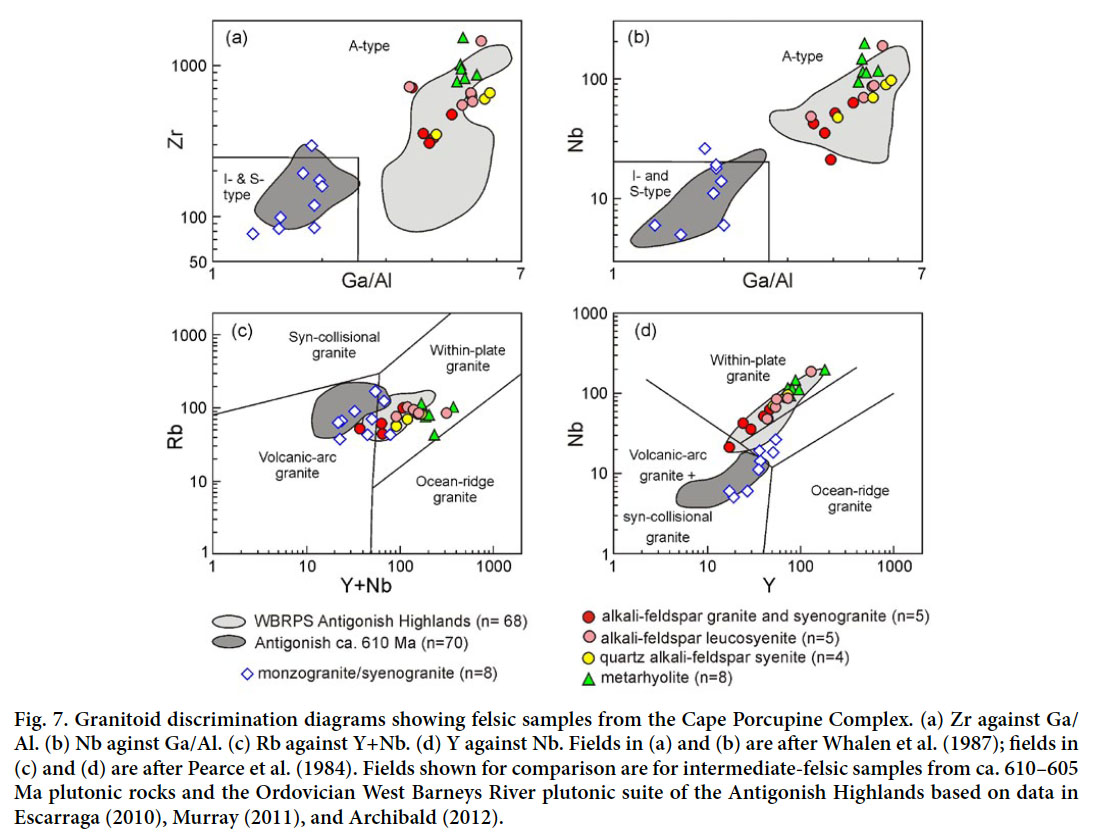 Display large image of Figure 7
Display large image of Figure 727 On all of these diagrams, the granitic samples are similar to the ca. 610–605 Ma plutonic rocks with similar SiO2 contents in the Antigonish Highlands, shown as fields on the diagrams. The Antigonish Highlands plutons are part of an expanded I-type granitoid suite that ranges in composition from dioritic to granitic and likely formed in a continental margin subduction zone (Escarraga 2010; Murray 2011). In contrast, the syenitic samples from the Cape Porcupine Complex, as well as the metarhyolite samples, show similarity to the Ordovician West Barneys River plutonic suite of the Antigonish Highlands. The tectonic setting for the West Barneys River suite is uncertain, but they are A-type granitoid rocks formed in an extensional setting (Escarraga et al. 2012). Hence the chemical data suggest that the igneous units in the Cape Porcupine Complex are correlative with units of similar ages in the Antigonish Highlands.
28 Rare-earth element data are not available for all of the samples from the Cape Porcupine Complex, but existing data are consistent with this proposed correlation (Fig. 8). Two granitic samples show moderate light REE enrichment and flat-heavy REE patterns, similar to the field defined by samples from ca. 610–605 Ma plutons in the Antigonish Highlands (Fig. 8a; Table 3). Four syenitic samples and one metarhyolite sample show similar chondrite-normalized patterns, with light REE enrichment (200 to 400 times chondritic values) and gently sloping heavy REE at 20 to 40 times chondritic values, and lie in the field defined by felsic samples from the West Barneys River suite (Fig. 8b). The strong negative Eu anomalies in all of these samples are consistent with feldspar fractionation, documented to be a major factor in magma evolution in both the ca. 610–605 Ma and Ordovician suites in the Antigonish Highlands (Escarraga 2010; Archibald 2012; Escarraga et al. 2012).
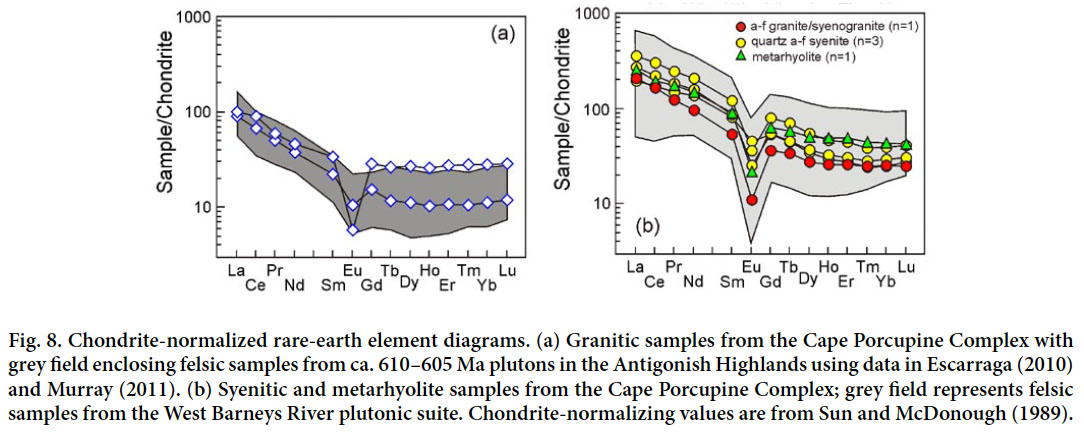 Display large image of Figure 8
Display large image of Figure 8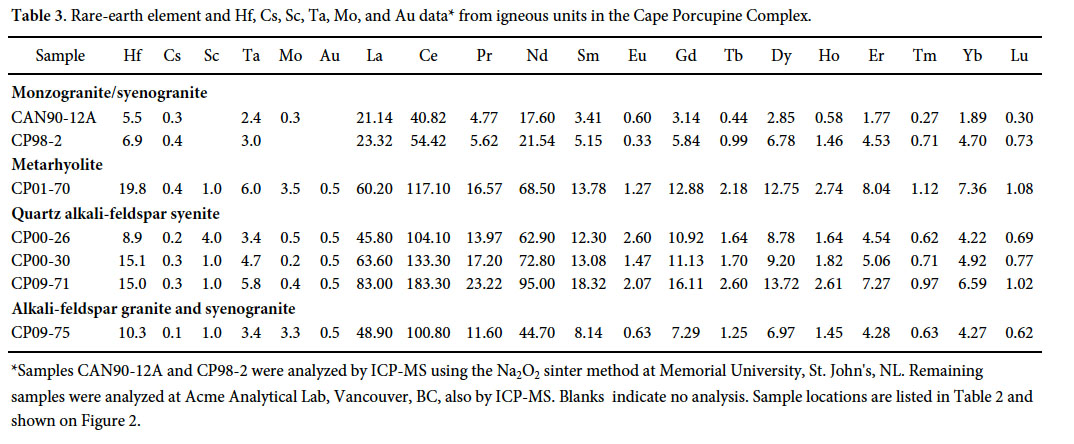 Display large image of Table 3
Display large image of Table 3Mafic rocks
29 The four analyzed leucodiorite samples are low in SiO2 (40–45%), suggesting that they may originally have been leucogabbro. Their high Al2O3 and CaO are consistent with the abundance of plagioclase, although its original composition cannot be determined due to pervasive alteration to epidote, zoisite/clinozoisite, and high MgO and Fe2O3t with the abundance of chlorite and amphibole. These highly altered rocks are notably low in TiO2 and P2O5 . Their distinctly different compositions suggest that they are not directly related to the other igneous units in the Cape Porcupine Complex.
30 Four mafic dykes, one cutting each of the metasedimentary and metarhyolite units and two in the ca. 610 Ma monzogranite/syenogranite unit, were also analyzed. All four dykes contain about 48% SiO2 and show chemical similarities to one another and to gabbroic samples with similar SiO2 contents in the West Barneys River plutonic suite (Fig. 5). Especially notable are the high TiO2 and Fe2O3t (Fig. 5a, c). Like the West Barneys River gabbroic samples, the dykes are tholeiitic transitional to alkalic based on Nb/Y ratio (Fig. 6a). On tectonic setting discrimination diagrams for mafic rocks, they plot in the within-plate basalt fields, and also in the field defined by mafic samples from the West Barneys River suite (Fig. 9a, b). These chemical similarities to gabbroic rocks in the West Barneys River plutonic suite suggest that the analyzed mafic dykes may also be Ordovician. If so, they indicate a minimum age for the metasedimentary and metarhyolite units, and for the mylonitic deformation as the mafic dykes in those units are not mylonitic.
DISCUSSION
31 Based on the presence of metasedimentary, metavolcanic and granitic rocks, Fletcher (1881, 1984), Ferguson (1946), Ferguson and Weeks (1950), and Keppie (2000) correlated the rocks at Cape Porcupine with the metamorphic and granitic rocks exposed in the area now known as the Bras d’Or terrane of adjacent Cape Breton Island (Fig. 1). However, the metamorphic rocks in the Bras d’Or terrane area characterized by abundant marble and calc-silicate rocks that are not present in the Cape Porcupine Complex (e.g., Raeside and Barr 1990; Keppie et al. 1998). Also, granitoid rocks in the Bras d’Or terrane are not mineralogically or texturally similar to those in the Cape Porcupine Complex. Their ages of ca. 560–550 Ma (e.g., Keppie et al. 2000; White et al. 2003) are not similar to the ca. 610 Ma and 478 Ma ages obtained from the Cape Porcupine Complex granitic and syenitic units, respectively.
32 White et al. (2003) assumed that all of the granitoid rocks in the western part of the Cape Porcupine Complex are ca. 610 Ma and that those in the eastern belt are ca. 478 Ma, and hence that the eastern and western granitoid belts are not related. However, the chemical data presented here suggest that ca. 610 Ma granitoid rocks are not as abundant as assumed by White et al. (2003) and that in fact most of the plutonic rocks in the western part of the complex are syenitic, like those in the eastern part. White et al . (2003) suggested that the close spatial association between the metarhyolite unit and the eastern syenitic unit indicated that they might be of similar age. The chemical data presented here support this interpretation and suggest that the metarhyolite could be the extrusive equivalent of the ca. 478 Ma syenitic suite.
33 White et al. (2001, 2003) recognized that the presence of ca. 610 Ma granitic rocks in the Cape Porcupine Complex suggests a connection with Avalonia, where volcanic and plutonic rocks of approximately that age are a characteristic feature (e.g., Hibbard et al. 2006; Thompson et al. 2010). However, White et al. (2003) were puzzled by the ca. 478 Ma age because in 2003, no Ordovician ages had been reported from Avalonia in the Antigonish Highlands or Mira terrane. At that time, the volcanic rocks of the Dunn Point Formation
34 in the western Antigonish Highlands (Fig. 1) were thought to be Silurian, and hence a connection with that igneous activity was not considered. However, subsequent dating showed that the Dunn Point Formation is Ordovician (ca. 460 Ma; Hamilton and Murphy 2004) and more recent work has demonstrated that overlying rhyolite of the McGillivray Brook Formation (Fig. 1) has a similar Ordovician age of 454.5 ± 0.7 Ma (Murphy et al . 2012). These felsic rocks have compositions similar to A-type granites and were interpreted to represent on-going extension following on from that represented by the West Barneys River plutonic suite at ca. 469 Ma (Escarraga et al. 2012; Murphy et al. 2012). The syenitic suite and metarhyolite in the Cape Porcupine Complex appear to extend this period of A-type extensional and bimodal magmatism in this part of Avalonia back to at least 478 Ma.
35 The age of the metasedimentary unit in the Cape Porcupine Complex remains unresolved. However, the pelitic (muscovite-rich) composition of the metasedimentary unit is more similar to the sedimentary rocks interbedded with flows of the mid-Ordovician Dunn Point and McGillivray Brook formations than to the Neoproterozoic sedimentary units of the Antigonish Highlands (White et al. 2011). This interpretation is consistent with the close association and possible interlayering of the metarhyolite and metasedimentary units of the Cape Porcupine Complex, but if correct, indicates that the metarhyolite may be at least 18 million years younger than the ca. 478 Ma syenitic suite.
36 The absence of any of these units, distinctive in both age and petrological characteristics, on the eastern side of the Strait of Canso supports the importance of major offset along the Canso Fault, as postulated by Barr and Raeside (1989). The mylonitic fabric so pervasive in rocks in the eastern half of the Cape Porcupine Complex (Fig. 2) may be direct evidence for the Canso Fault which offsets terranes of Cape Breton Island relative to those of northern mainland Nova Scotia (Fig. 1, inset).
 Display large image of Figure 9
Display large image of Figure 9CONCLUSIONS
37 White et al. (2003) concluded that the relationship of the Cape Porcupine Complex to other igneous and metamorphic rocks in adjacent parts of Cape Breton Island and northern mainland Nova Scotia was unclear, and hence that its terrane affiliation was uncertain. Based on age and petrological similarities, it is likely that the ca. 610 Ma granitic rocks in the Cape Porcupine Complex formed as part of the same plutonic event as rocks of similar age in the Antigonish Highlands. The Ordovician age and A-type characteristics of the syenitic rocks in the Cape Porcupine Complex match well with those of the syenitic rocks in the West Barneys River plutonic suite in the Antigonish Highlands, and the age of 478 ± 3 Ma obtained for alkali-feldspar granite in the Cape Porcupine Complex extends this episode of igneous activity back to at least the Early Ordovician. Hence the results of this study show that the Cape Porcupine Complex is geologically linked to the Antigonish Highlands and is no longer a geological orphan in terrane reconstructions. The lack of similarities between the components of the Cape Porcupine Complex and rocks in adjacent Cape Breton Island further demonstrates the regional significance of the Canso Fault in tectonic reconstructions.
NOTE ADDED IN PROOF
38 A preliminary U-Pb (zircon) age of 482 ± 4 Ma from quartz alkali feldspar leucosyenite sample CAN90-5 (Fig. 2) confirms that the leucosyenite unit is Ordovician in age and supports the correlations proposed here based on petrological data.
This work was funded in part by a Discovery Grant to Sandra Barr from the Natural Sciences and Engineering Research Council of Canada. We are grateful to journal reviewers Andy Kerr and Brendan Murphy for their helpful reviews which resulted in substantial improvements in the manuscript.
